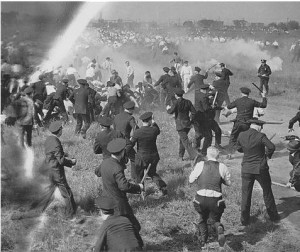Historical Moments of Policing, Violence, & Resistance #2: 1937 Memorial Day Massacre
Sam introduces the story of the 1937 Memorial Day Massacre below:
What we today call the Memorial Day Massacre of 1937 occurred when Chicago police officers opened fire on a group of 1000 protestors attempting to establish a picket line in front of Republic Steel, on the city’s southeast side. Similar to the Haymarket Tragedy fifty years earlier, no direct documentation exists from which to ascertain how the violence began that Sunday afternoon. A Paramount news cameraman filmed much of the march and the brutal beatings police laid on injured and fleeing protestors, but he was changing lenses at the moment shots rang out, leaving open questions of interpretation about what sparked the violence. In the days and months that followed two narratives emerged, strikingly different in the way they explained the cause of the massacre and the events that led up to it.
The story of how this became known as the Memorial Day Massacre is one of how the victims of police violence, with their allies in law and elected office, in the labor movement, in their communities, and in radical political organizations countered a hostile and wildly inaccurate report of details to reframe public perception and reveal a brutal display of class violence perpetrated against working people by state and capital through their agents, the police.
This much was certain: Around four o’clock in the afternoon at 117th Street the protestors encountered a line of Chicago police officers, 200 in number. By the end of the day four protestors were dead and nearly 100 hospitalized with serious injuries. Another six men would die before the week’s end. The police sustained no major injuries. Many of the 65 people they arrested were seriously wounded.
The Chicago Tribune immediately built a narrative which established the protestors as the provocateurs, justifying the police’s use of lethal violence to stop an enraged mob, led or inspired by communists, intending to invade the mill and forcibly halt production. Coroner Frank Walsh personally declared to “fix the blame” on “the mob.” His report ruled the death of the ten men as ‘justifiable homicide,’ despite the fact that the deceased’s wounds were on their backs or sides, indicating they were trying to flee, not attack, the police. Together with police testimony, forces loyal to the Republic Steel corporation engaged in Red-baiting as a means to shape public and legal perception of the incident.
Read more about the 1937 Memorial Day Massacre in the following new pamphlet (PDF) by Samuel Barnett. Readers of Prison Culture are the first to access the publication (lucky you!).
If you are in Chicago this weekend, join us on Saturday from 1:30 to 4:30 p.m. at UIC and listen to Sam talk a bit about this pamphlet. Details about the event are here.

